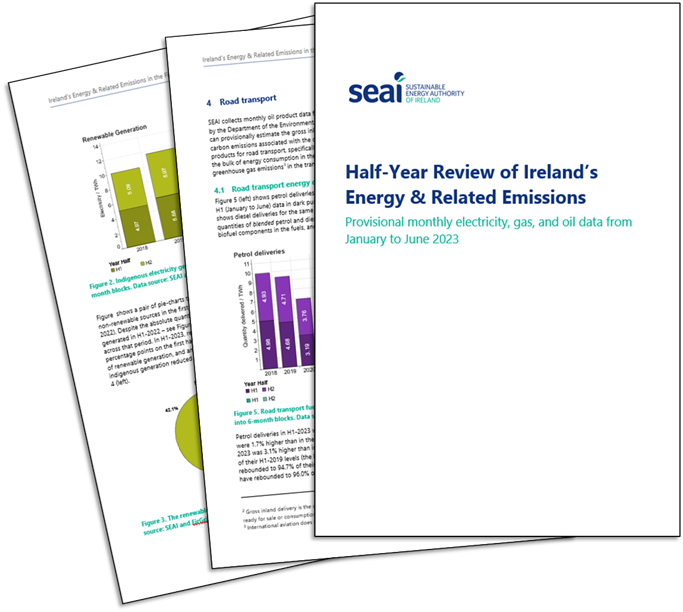Half-Year Review - Ireland’s Energy & Related Emissions
The ‘half-year review’ of the electricity-generated, oil-delivered, and gas-supplied into the Irish market in the first 6-months of 2023 compares data from this period to what has been observed in previous years.
The availability of timely and trusted data on Ireland’s energy has never been more important. Policy updates and targets are operating on increasingly shorter timescales to drive faster annual emission reductions and guide us toward net-zero emissions by 2050.
This short note supports timely and informed discussions on these energy policies and targets, by accelerating the pace at which key data and insights on Ireland’s energy and related CO2 emissions are published by SEAI. This note leverages the provisional monthly data collected to satisfy Ireland’s international reporting obligations to the EU, to make early in-year estimates on key areas of energy supply and emissions.

Half-Year Review - Ireland’s Energy & Related Emissions
The report helps identify trends and insights into energy supply and related emissions.
Key points of interest
- Ireland’s electricity emissions in the first half of 2023 (i.e. H1-2023) were 16.7% lower than in the same period in 2022.
- The quantity of electricity generated from renewables in H1-2023 was 2.8% lower than in the same period in 2022, mainly due to the variability and weather-dependence of wind-generation.
- Indigenous generation of electricity in H1-2023 was 5.0% lower than in the same period in 2022.
- In H1-2023, renewable sources accounted for 43.0% of electricity generated in Ireland, up by 0.9 percentage points on the first half of the previous year.
- Ireland’s electricity demand in H1-2023 was 2.5% higher than in the same period in 2022.
- In H1-2023, net-imports accounted for 8.2% of Ireland’s electricity demand.
- Ireland’s increased use of imported electricity over indigenous generation was the key driver of the reduced emissions observed in H1-2023.
- Petrol deliveries in H1-2023 were 9.1% higher than in the same period in 2022.
- Diesel deliveries in H1-2023 were 1.7% higher than in the same period in 2022.
- H1-2023 deliveries of diesel and petrol have rebounded to 99.5% and 94.7% of their H1-2019 levels (the last H1-period not affected by COVID impacts), respectively.
- Road transport emissions in H1-2023 were 2.4% higher than in the same period in 2022.
- If the upward trend in road transport emissions for H1-2023 continues into H2-2023, then overall transport emissions in 2023 will be higher than those in 2022.
- To stay within the transport sector’s Sectoral Emission Ceiling (SEC) of 54 MtCO2e in the 2021-2025 carbon budget period, transport sector emissions in 2023 need to be going down.
- Demand for residential gas and kerosene ‘heating oil’ in H1-2023 were both 26% lower than in the same period 2-years ago (i.e. H1-2021).
- Recent reductions in residential heat demand are likely due to a range of factors, including price elasticity, weather effects, fuel-switching due to upgrades, and changing work-from-home behaviours.
- Residential gas demand in H1-2023 was 15.8% lower than in the same period in 2022.
- Kerosene ‘heating oil’ demand in H1-2023 was 2.4% lower than in the same period in 2022.
- Approximately half of Ireland’s consumption of natural gas is for electricity generation.
- Ireland’s indigenous gas supply in H1-2023 was 15.4% lower than in the same period in 2022, driven by declining output from the Corrib gas fields.
- 5-years previously (in H1-2018), Ireland’s indigenous gas supply was three times higher than H1-2023 levels.
- In H1-2023, 76.8% of Ireland’s gas supply was imported.
- 5-years previously (in H1-2018), 35.6% of Ireland’s gas supply was imported.
While provisional estimates based on monthly data are not as definitive as the annual data published by SEAI in the annual National Energy Balance, or by the EPA in the National Greenhouse Gas Emissions Inventory, monthly surveys offer far greater timeliness. Analysis of monthly data is typically available just a few weeks after the fact, making it ideal for the early identification of shifts and trends in energy and emissions that will later be more fully quantified and verified by definitive annual surveys. The complementary use of both fast-but-provisional monthly data and slow-but-definitive annual data balances the competing needs of timeliness and authority in Ireland’s energy statistics.
Going forward, SEAI aims to deliver this note in early September of each year, synchronised to the release of the full National Energy Balance. The co-publication of definitive annual data from the previous year (in the energy balance) with the provisional monthly data from the first 6-months of the current year (in the half-year review note) will deliver a more complete and current assessment of Ireland’s national energy system.